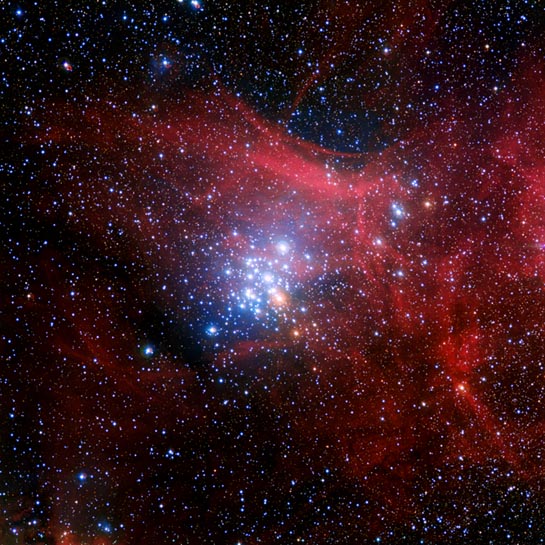
Description: Star Cluster
Position (J2000): RA 10h 35m 46.96s Dec -58° 13' 4.19"
Constellation: Carina
Visual magnitude: 4.7
Angular dimensions: 6 arc-min
Distance: 8000 light years
Field of view: 34.44 x 33.47 arcminutes
Orientation: North is 0.0° left of vertical
Image Credit: ESO/G. Beccari
Release date: July 23, 2014
ABOUT THIS IMAGE:
In this striking new image from ESO’s La Silla Observatory in Chile young stars huddle together against a backdrop of clouds of glowing gas and lanes of dust. The star cluster, known as NGC 3293, would have been just a cloud of gas and dust itself about ten million years ago, but as stars began to form it became the bright group of stars we see here. Clusters like this are celestial laboratories that allow astronomers to learn more about how stars evolve.
This beautiful star cluster is found 8000 light-years from Earth in the constellation of Carina (The Keel). This cluster was first spotted by the French astronomer Nicolas-Louis de Lacaille on January 25, 1752, during his stay in what is now South Africa, using a tiny telescope with an aperture of just 12 millimeters. It is one of the brightest clusters in the southern sky and can be easily seen with the naked eye on a dark clear night. It consists of more than 50 stars in a 10 arc-minute field, the brightest of which is a red giant with a magnitude of 6.5.
Star clusters like NGC 3293 contain stars that all formed at the same time, at the same distance from Earth and out of the same cloud of gas and dust, giving them the same chemical composition. As a result clusters like this are ideal objects for testing stellar evolution theory.
Most of the stars seen here are very young, and the cluster itself is less than 10 million years old. Just babies on cosmic scales if you consider that the Sun is 4.6 billion years old and still only middle-aged. An abundance of these bright, blue, youthful stars is common in open clusters like NGC 3293, and, for example, in the better known Kappa Crucis cluster, otherwise known as the Jewel Box or NGC 4755.
These open clusters each formed from a giant cloud of molecular gas and their stars are held together by their mutual gravitational attraction. But these forces are not enough to hold a cluster together against close encounters with other clusters and clouds of gas as the cluster’s own gas and dust dissipates. So, open clusters will only last a few hundred million years, unlike their big cousins, the globular clusters, which can survive for billions of years, and hold on to far more stars.
Despite some evidence suggesting that there is still some ongoing star formation in NGC 3293, it is thought that most, if not all, of the nearly fifty stars in this cluster were born in one single event. But even though these stars are all the same age, they do not all have the dazzling appearance of a star in its infancy; some of them look positively elderly, giving astronomers the chance to explore how and why stars evolve at different speeds.
Take the bright orange star at the bottom right of the cluster. This huge star, a red giant, would have been born as one of the biggest and most luminous of its litter, but bright stars burn out fast. As the star used up the fuel at its core its internal dynamics changed and it began to swell and cool, becoming the red giant we now observe. Red giants are reaching the end of their life cycle, but this red giant’s sister stars are still in what is known as the pre-main-sequence — the period before the long, stable, middle period in a star’s life. We see these stars in the prime of their life as hot, bright and white against the red and dusty background.
This image was taken with the Wide Field Imager (WFI) installed on the MPG/ESO 2.2-meter telescope at ESO’s La Silla Observatory in northern Chile.